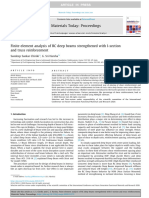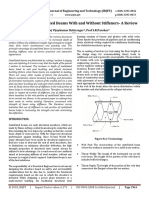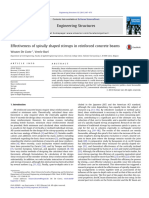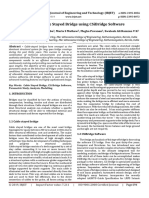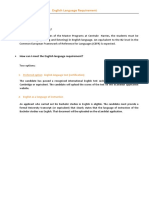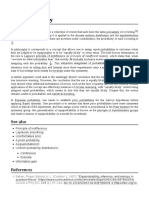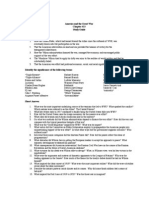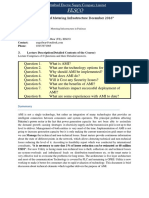Comparison of Design Calculations of Deep Beams Using Various International Codes
Comparison of Design Calculations of Deep Beams Using Various International Codes
Uploaded by
Igor BarcelosCopyright:
Available Formats
Comparison of Design Calculations of Deep Beams Using Various International Codes
Comparison of Design Calculations of Deep Beams Using Various International Codes
Uploaded by
Igor BarcelosOriginal Description:
Original Title
Copyright
Available Formats
Share this document
Did you find this document useful?
Is this content inappropriate?
Copyright:
Available Formats
Comparison of Design Calculations of Deep Beams Using Various International Codes
Comparison of Design Calculations of Deep Beams Using Various International Codes
Uploaded by
Igor BarcelosCopyright:
Available Formats
See discussions, stats, and author profiles for this publication at: https://www.researchgate.
net/publication/289970058
Comparison of design calculations of Deep beams using various International
Codes
Article in International Journal of Civil Engineering · November 2015
DOI: 10.14445/23488352/IJCE-V2I10P104
CITATION READS
1 1,599
3 authors, including:
Firoz ALAM Faroque Rishikesh Kumar
Manipal University Jaipur (MUJ) Manipal University
3 PUBLICATIONS 1 CITATION 2 PUBLICATIONS 1 CITATION
SEE PROFILE SEE PROFILE
Some of the authors of this publication are also working on these related projects:
Bio-composite View project
All content following this page was uploaded by Firoz ALAM Faroque on 11 January 2016.
The user has requested enhancement of the downloaded file.
SSRG International Journal of Civil Engineering (SSRG-IJCE) – volume 2 Issue 10 October 2015
Comparison of design calculations of Deep beams using
various International Codes
Firoz Alam Faroque 1, Rishikesh Kumar 2
1
Assistant Professor, Civil Engineering Department, Manipal University Jaipur, Dehmi Kalan, Jaipur, India
2
Assistant Professor, Civil Engineering Department, Manipal University Jaipur, Dehmi Kalan, Jaipur, India
Abstract: A deep beam is a structural member whose
behaviour is dominated by shear deformations. Until
recently, the design of deep beams per U.S. design
standards was based on empirically derived
expressions and rules of thumb. For structural
members exposed to public view or environmental
elements, the serviceability performance of the
structure is arguably as significant as its strength.
Typically, the serviceability performance of reinforced
concrete deep beams is quantified by the width and
spacing of diagonal cracks that form under the
application of service loads. In design, diagonal Fig.1: A typical cross section of deep beam.
cracking in service can be limited by comparing the
cracking load to the service load and adjusting the The structural design standards, AASHTO
section as necessary. Also, web reinforcement can be LRFD (2008) and ACI 318-08, adopted the use of
provided to restrain the width of diagonal cracks if strut-and-tie modelling (STM) for the strength design
they do happen to form in service. Currently, the of deep beams or other regions of discontinuity in
minimum web reinforcement provisions in various 1994 and 2002, respectively. Based on the theory of
design specifications are inconsistent and in general, plasticity, STM is a design method that idealizes stress
do not address whether the required reinforcement fields as axial members of a truss. The primary
considers serviceability demand as well as strength advantage of STM is its versatility. It is valid for any
demand. In this paper, the design of deep beam has given loading or geometry. However, the primary
been carried out using three codes namely the Indian weakness of STM is also its versatility. The freedom
standard code, the American Concrete Institute code associated with the method results in a vague and
and the Construction Industry Research and inconsistently defined set of guidelines. Because of
Information Association code. The results have been the lack of a well-ordered design process, many
obtained on the various designs that have been done practitioners are reluctant to use STM.
based on these methods and they have been tabulated For structural members exposed to public
and the graphs plotted. view or environmental elements, the serviceability
performance of the structure is arguably as significant
Keywords — ACI, CIRIA, IS Code, Deep Beam, as its strength. Typically, the serviceability
Shear. performance of reinforced concrete deep beams is
quantified by the width and spacing of diagonal cracks
I. INTRODUCTION that form under the application of service loads. In
design, diagonal cracking in service can be limited by
A deep beam is a beam having a depth comparable
comparing the cracking load to the service load and
to the span length. Reinforced concrete deep beams
adjusting the section as necessary. Also, web
have useful applications in tall buildings, offshore
reinforcement can be provided to restrain the width of
structures, and foundations. The transition from
diagonal cracks if they do happen to form in service.
ordinary-beam behaviour to deep-beam behaviour is
Currently, the minimum web reinforcement provisions
imprecise; for design purposes, it is often considered
in various design specifications are inconsistent and in
to occur at a span/depth ratio of about 2.5. The
general, do not address whether the required
importance of the shear-span/depth ratio and for
reinforcement considers serviceability demand as well
buckling and instability the depth/thickness ratio are
as strength demand. Hence, another goal of the current
very important. In practice, engineers typically
research project is to improve the serviceability design
encounter deep beams when designing transfer girders,
provisions for deep beams by recommending an
pile supported foundations, or bridge bents. Until
appropriate amount of minimum web reinforcement
recently, the design of deep beams per U.S. design
and by outlining a service-load check to assess the
standards was based on empirically derived
likelihood of diagonal cracking.
expressions and rules of thumb.
While current design concepts are based on
uniaxial stress-strain characteristics, recent work has
ISSN: 2348 – 8352 www.internationaljournalssrg.org Page 18
SSRG International Journal of Civil Engineering (SSRG-IJCE) – volume 2 Issue 10 October 2015
shown quite conclusively that the ultimate limit-state A) L/D ratio and tensile reinforcement by ACI, IS, and
behaviour of reinforced concrete (RC) elements such CIRIA code
as, for example, beams in flexure (or combined
flexure and shear), can only be explained in terms of B) L/D ratio and shear reinforcement by ACI, IS and
multiaxial effects which are always present in a CIRIA code
structure. It is the consideration of the multiaxial c) L/D ratio and total reinforcement by ACI, IS and
effects that has led to the introduction of the concept CIRIA code 31
of the compressive-force path which has been shown
not only to provide a realistic description of the causes Problem: III
of failure of structural concrete, but also to form a
suitable basis for the development of design models Length of the beam=5.5m
capable of providing safe and efficient design Initial load coming on the beam is =1000 kn/m
solutions. In the following, the work is summarised
and the concept of the compressive force path is used Initial depth of the beam=5.5m
as the basis for the description of the behaviour of RC
deep beams of their ultimate limit state. The In this study we have decreased the depth of the beam
implications of the application of the concept in RC by 200 mm in every step and we have increased the
loading by 100 kN/m in every step. This is a very
deep beam design are also discussed and a simple
interesting study because here we have changed the
design method is proposed.
loading as well as the depth of the beam in order to get
variable moment and variable L/D ratio. For this study
we have drawn graphs between the following
II.PROBLEM FORMULATION
Following are the problems which have been studied A) L/D ratio and tensile reinforcement by ACI, IS, and
in this work. CIRIA code
Problem I: B) L/D ratio and shear reinforcement by ACI, IS and
CIRIA code
Length of the beam = 5m
c) L/D ratio and total reinforcement by ACI, IS and
Initial depth of the beam = 5m CIRIA code
Load coming on the beam=1000 kn/m Problem: IV
For this problem we have decreased the depth of the Length of the beam=5.5m
beam by 200 mm in step of the problem to increase
the L/D ratio. By keeping the loading length and Initial load coming on the beam is =1000 kn/m
moment of the beam constant, we have decreased the Initial depth of the beam=5.5m
depth of the beam in every step for a different L/D
ratio, then we have drawn graphs between In this study we have decreased the depth of the beam
by 200 mm in every step and we have increased the
A) L/D ratio and Tension reinforcement by ACI, IS loading by 100 kn/m in every step. This is a very
and CIRIA codes interesting study because here we have changed the
B) L/D ratio and Shear reinforcement by ACI, IS and loading as well as the depth of the beam in order to get
CIRIA codes variable moment and variable L/D ratio. For this study
we have drawn graphs between the following
c) L/D ratio and total reinforcement by ACI, IS and
CIRIA codes A) L/D ratio and tensile reinforcement by ACI, IS, and
CIRIA code
Problem II:
B) L/D ratio and shear reinforcement by ACI, IS and
Length of the beam=5m CIRIA code
Initial depth of the beam=5m c) L/D ratio and total reinforcement by ACI, IS and
CIRIA code 32 (V)
Initial load coming on the beam is =1000 kn/m
Problem: V
In this study we have decreased the depth of the beam
by 200 mm in every step and we have increased the Length of the beam=4.55m
loading by 100 kn/m in every step. This is a very
interesting study because here we have changed the Initial load coming on the beam is =1000 kn/m
loading as well as the depth of the beam in order to get Initial depth of the beam=4.5m
variable moment and variable L/D ratio. For this study
we have drawn graphs between the following
ISSN: 2348 – 8352 www.internationaljournalssrg.org Page 19
SSRG International Journal of Civil Engineering (SSRG-IJCE) – volume 2 Issue 10 October 2015
In this study we have decreased the depth of the beam anchorage failure or a bearing failure (occurring in
by 200 mm in every step and we have increased the regions acted upon by concentrated loads), are usually
loading by 100 kn/m in every step. This is a very prevented by proper detailing.
interesting study because here we have changed the Although a generally accepted theory describing the
loading as well as the depth of the beam in order to get causes of shear failure is currently lacking, there are a
variable moment and variable L/D ratio. For this study number of concepts which not only are widely
we have drawn graphs between the following considered as an essential part of such a theory, but
A) L/D ratio and tensile reinforcement by ACI, IS, and also form the basis of current design methods for shear
CIRIA code design. These concepts are the following:
B) L/D ratio and shear reinforcement by ACI, IS and i) Shear failure occurs when the shear capacity of a
CIRIA code critical cross section is exceeded
ii) The main contributor to shear resistance is the
c) L/D ratio and total reinforcement by ACI, IS and
CIRIA code portion of the cross section below the neutral axis,
with strength, in the absence of shear reinforcement,
Problem: VI being provided by “aggregate interlock” and “dowel
Length of the beam=4.5m action”, whereas for a beam with shear reinforcement
the shear forces are sustained as described.
Initial load coming on the beam is =1000 kn/m iii) Once inclined cracking occurs, an RC beam with
Initial depth of the beam=4.5m shear reinforcement behaves as a truss with concrete
between two consecutive inclined cracks and shear
In this study we have decreased the depth of the beam
by 200 mm in every step and we have increased the reinforcement acting as the struts and ties of the truss,
loading by 100 kn/m in every step. This is a very respectively, and the compressive zone and tension
interesting study because here we have changed the reinforcement representing the horizontal members.
loading as well as the depth of the beam in order to get
variable moment and variable L/D ratio. For this study A common feature of both the above concepts and the
we have drawn graphs between the following plane section theory that form the basis of flexural
design is that they rely entirely on uniaxial stress-
A) L/D ratio and tensile reinforcement by ACI, IS, and strain characteristics for the description of the
CIRIA code behaviour of concrete.
B) L/D ratio and shear reinforcement by ACI, IS and This view may be justified by the fact that beams are
CIRIA code designed to carry stresses mainly in the longitudinal
direction, with the stresses developing in at least one
c) L/D ratio and total reinforcement by ACI, IS and of the transverse directions being small enough to be
CIRIA code assumed negligible for any practical purpose. As will
be seen, however, such a reasoning underestimates the
III. METHODOLOGY considerable effect that small stresses have on the
load-carrying capacity and deformational response of
The three methods for designing the beams are
concrete. Ignoring the small stresses in design does
followed according to the codes of the three countries
not necessarily mean that their effect on structural
i.e. The IS code, the ACI code and the CIRIA code. It
behaviour is also ignored. It usually means that their
is a common design practice first to design an RC
effect is attributed to other causes that are expressed in
beam for flexural capacity and then to ensure that any
the form of various design assumptions.
type of failure, other than flexural (that would occur
when the flexural capacity is attained), is prevented. The following are the steps in brief which are involved
The flexural capacity is assessed on the basis of the in the process of design of deep beams:
plane sections theory which not only is generally
considered to describe realistically the deformational 1. Check of deep beam: According to IS 456, a
response of the beams, but is also formulated so that it simply supported beam is termed as deep when ratio
provides a design tool noted for both its effectiveness of its effective span L to overall depth D is less than 2.
and simplicity. However, an RC beam may exhibit a Continuous beams are considered as deep when the
number of different types of failure that may occur ratio L/D is less 2.5.This is same as that of British
before flexural capacity is attained. The most common code but ACI 318 defines simple beams with ratio L/D
of such failures are those which may collectively be less than 1.25 as deep beams. Continuous beams are
referred to as shear types of failure and may be considered as deep when the clear span/depth ratio (i.e.
prevented by complementing the initial (flexural) L/D) is less than 2.5.
design so that the shear capacity of the beam is not
exhausted before the flexural capacity is attained,
while other types of failure such as, for example, an
ISSN: 2348 – 8352 www.internationaljournalssrg.org Page 20
SSRG International Journal of Civil Engineering (SSRG-IJCE) – volume 2 Issue 10 October 2015
Determination of Design Bending Moment:
In a simply supported beam, the bending moment is
calculated as in ordinary beams. For a total load w
uniformly distributed on the beam
Typical detailing guideline for a section of a deep
beam for tension:
In a continuous beam the bending moment, according
to American practice for a uniformly distributed load,
w per unit length is as follows:
At mid Span, , Positive
At face of support, ,
Negative Fig.2 Placement of tension steel in deep beams
Where, e is the ratio of width of support to effective
4. Design for Shear in IS 456:
span.
No separate checking for shear is specified in IS 456.
2. Check for compression in concrete We assume that arching action of the main tension
Even though stresses in compression in concrete in steel and the web steel together with concrete will
deep beams are always low, a routine check should be carry the shear. In simply-supported beam the arching
made to estimate the maximum compression in action as shown in Fig. 3.2 can be depended on if the
concrete by the standard beam formula. main tension steel is properly detailed. However, in
3. Determination of Area of Tension Steel continuous beams, this arch action is not present and
The area of steel to carry the tension is determined by ACI recommends that we should design them as in
the empirical method of assuming a value for the lever ordinary beam. Unlike the IS code, the British practice
arm. IS 456 Clause 29.2 follows the committee euro requires numerical calculations for design of deep
international du Benton and gives the following values beams for shear. The design is based on the results of
for z, the lever arm length. research carried out by Kong and others. It is
For simply supported beams, applicable only to simply-supported beams of span
Z=0.2(L+2D), when L/D is between 1 and 2 depth ratio not exceeding two. The shear analysis is
=0.6 L, when L/D is less than 1. carried out by assuming a structural idealization of
For Continuous Beams, 'critical diagonal tension failure line' along the natural
load path which in the case of concentrated loads is
Z=0.5L, When L/D is less than 1
taken as the line joining the load and the support.
=0.2 (L+1.5D) when L/D is between 1 and 2.5
From these Values,
Mu =Asfsz,
Where fs=0.87fy in limit state design.
Also,
The value recommended as the value of z by Kong is
the lesser of the two values given by the following
equations:
It will be z=0.6L when L/D<1 and z=0.6D when L/D
≥ 1.
The CIRIA guide recommends the CEB values given
in IS 456. The values of steel area obtained are kept
very conservative as the tension steel is also assumed
to contribute to the shear resistance of the beam in
British practice.
We get the equations:
Fig.3 Design for shear in deep beams by ACI Method
IV. RESULTS AND DISCUSSIONS
The deep beams of three dimensions were chosen for
the analysis. The beam of length 4.5m, 5m & 5.5m
ISSN: 2348 – 8352 www.internationaljournalssrg.org Page 21
SSRG International Journal of Civil Engineering (SSRG-IJCE) – volume 2 Issue 10 October 2015
were taken and were designed. While performing the In the given plot of total reinforcement, for IS and
design calculations their results were enlisted and ACI plots show consistency and a similar nature
were plotted .Also the results were compared to see whereas IS code give a higher value for the same L/D
the variation in the behaviour. The calculations have ratio in the given plot.
been done based on the IS code, CIRIA code and the
ACI code keeping the moment Vu constant and then 1.2 Moment and Shear variable for a 5m deep
they have been recalculated by varying them. beam: In this study we have decreased the depth of
1.1 Moment and Shear constant for a 5m deep the beam by 200 mm in every step and we have
beam: increased the loading by 100 kn/m in every step. This
is a very interesting study because here we have
changed the loading as well as the depth of the beam
in order to get variable moment and variable L/D
ratio.
Fig. 4: Comparison of Reinforcement vs L/D ratio for
IS,CIRIA and ACI
By keeping moment and shear force constant as we
increase L/D ratio CIRIA code gives the maximum
Fig. 7: Comparison of Reinforcement vs Moment(Mu)
tension reinforcement, ACI code gives the minimum
for IS,CIRIA and ACI
reinforcement and IS code gives the moderate
The plot of ACI and IS shows consistent and similar
reinforcement
behaviour whereas the CIRIA plot gives higheer
values of steel at higher values of moment.
Fig. 5 : Comparison of Shear Reinforcement vs L/D
ratio for IS,CIRIA and ACI Fig. 8: Comparison of Reinforcement vs Shear(Vu)
Up to L/D ratio 1.9 CIRIA code gives the maximum for IS,CIRIA and ACI
shear reinforcement, when L/D ratio is more than 2
ACI code gives more shear reinforcement.
Fig. 9: Comparison of Total Reinforcement vs L/D
Fig. 6: Comparison of Total Reinforcement vs L/D
ratio for IS,CIRIA and ACI
ratio for IS,CIRIA and ACI
ISSN: 2348 – 8352 www.internationaljournalssrg.org Page 22
SSRG International Journal of Civil Engineering (SSRG-IJCE) – volume 2 Issue 10 October 2015
Fig. 14: Comparison of Total Reinforcement vs
Fig. 10: Comparison of Shear Reinforcement vs L/D Moment(Mu) for IS,CIRIA and ACI
ratio for IS,CIRIA and ACI
Fig. 15: Comparison of Total Reinforcement vs
Shear(Vu) for IS,CIRIA and ACI
Fig. 11: Comparison of Shear Reinforcement vs 2.1 Moment and Shear constant for a 5m deep
Moment(Mu) for IS,CIRIA and ACI beam:
In this case a 4.5 m deep beam was taken analysed
keeping Moment and shear constant.The
corresponding plots are
Fig. 12 : Comparison of Shear Reinforcement vs
Shear(Vu) for IS,CIRIA and ACI Fig. 16: Comparison of L/D ratio vs Tensile
Reinforcement for a 4.5 m deep beam when Mu & Vu
constant
Fig. 13: Comparison of Total Reinforcement vs Fig. 17: Comparison of L/D ratio vs Shear
L/D ratio for IS,CIRIA and ACI Reinforcement for a 4.5 m deep beam when Mu & Vu
constant
ISSN: 2348 – 8352 www.internationaljournalssrg.org Page 23
SSRG International Journal of Civil Engineering (SSRG-IJCE) – volume 2 Issue 10 October 2015
Fig.18: Comparison of L/D ratio Vs Total
Reinforcement for A 4.5 m deep beam when Mu & Vu
Fig. 21: Comparison of Total reinforcement Vs L/D
constant
ratio for a 4.5 m deep beam when Mu & Vu varying
2.2 Moment and Shear variable for a 4.5 M deep
beam: 3.1 Moment and Shear constant for a 5.5 M deep
In this case a 5 m deep beam is taken and is analysed beam:
taking the values of Moment (Mu) and Shear (Vu) In this final case a 5.5 m deep beam has been taken
and the Moment and shear values has been kept
varying.
constant.
Fig. 19: Comparison of L/D ratio Vs tensile
reinforcement for a 4.5 m deep beam when Mu & Vu Fig. 22: Comparison of L/D ratio Vs Tensile
varying Reinforcement for a 5.5 M deep beam when Mu & Vu
constant
Fig. 20: Comparison of L/D ratio Vs Shear
reinforcement for a 4.5 m deep beam when Mu & Vu Fig. 23: Comparison of L/D ratio Vs Shear
varying Reinforcement for a 5.5 M deep beam when Mu & Vu
constant
ISSN: 2348 – 8352 www.internationaljournalssrg.org Page 24
SSRG International Journal of Civil Engineering (SSRG-IJCE) – volume 2 Issue 10 October 2015
Fig. 24: Comparison of Total Reinforcement Vs L/D Fig. 26: : Comparison of Total Reinforcement Vs L/D
ratio for a 5.5 M deep beam when Mu & Vu ratio for a 5.5 M deep beam when Mu & Vu varying
constant.
3.2 Moment and Shear variable for 5.5 m deep
beam: The above plots give us an indication of the anomalies
that arise in the behaviour of the results while
designing the same beam from different design codes.
When the load coming on the beam and length of the
beam is constant as L/D increases flexural steel
requirement also increases and CIRCA code gives the
maximum tensile reinforcement and that of ACI is
minimum and IS code gives moderate values for a 5m
length deep beam. In shear IS code gives maximum
shear reinforcement and that of CIRCA gives
minimum reinforcement but the total reinforcement
given by IS code is maximum and that of ACI code is
minimum. When we start to vary the load there is
Fig. 25: Comparison of Tensile Reinforcement Vs change in moment and shear then something changes.
L/D ratio for a 5.5 M deep beam when Mu & Vu Up to a L/D ratio 1.25 IS code gives maximum shear
varying reinforcement and after L/D ratio 1.25 ACI code gives
maximum shear reinforcement. But in comes to total
reinforcement up to L/D ratio 1.9 IS code gives
maximum reinforcement but as the L/D ratio increases
the total reinforcement given by ACI starts to govern.
The above results are compatible with the experiment
Analysis and Design of R.C. Deep Beams Using Code
Provisions of Different Countries and Their
Comparison in International Journal of Engineering
and Advanced Technology (IJEAT) by Sudarshan D.
Kore, S.S.Patil. ISSN: 2249 – 8958, Volume-2, Issue-
3.
Fig. 26: : Comparison of Shear Reinforcement Vs L/D V. CONCLUSIONS
ratio for a 5.5 M deep beam when Mu & Vu varying From the study on deep beams by various
international codes following conclusions are drawn:
1. When the load coming on the beam and
length of the beam are constant as L/D
increases flexural steel requirement also
increases and CIRIA code gives the
maximum tensile reinforcement and that of
ISSN: 2348 – 8352 www.internationaljournalssrg.org Page 25
SSRG International Journal of Civil Engineering (SSRG-IJCE) – volume 2 Issue 10 October 2015
ACI is minimum and IS code gives moderate [6] CIRIA Guide 2 (1977), “The design of deep beams in
reinforced concrete”, Over Arup and Partners and
values. Construction Industry Research and Information Association,
2. When it comes to shear (by keeping London, (reprinted 1984), 131 p.
maximum shear force constant) as the L/D [7] Design by Strut and Tie method using ACI Appendix A‟
from STM website.
ratio increases shear reinforcement also [8] Indian Standard Code of Practice Plain and Reinforced
increases and IS code gives the maximum Concrete‟ IS 456:2000-. Bureau of Indian Standards, Manak
shear reinforcement and CIRIA code gives Bhavan, New Delhi, India.
minimum shear reinforcement and ACI code [9] Marti Peter, „Basic Tools of Reinforced Concrete Beam
Design‟ ACI journal, Title no. 82-4, January-February 1985.
gives moderate reinforcement value. [10] Kong. F. K. „Reinforced Concrete Deep Beam‟ , Van No
3. When the load coming on the beam and strand Reinhold, New York
length of the beam is constant IS code gives [11] Mr.Kotsovos, „Design of Reinforced Concrete Deep
Beams‟ Journal of Structural Egg. 28-32, January 1988.
maximum total reinforcement and ACI code [12] Matamoros and Wong, „Design of Simply Supported Deep
gives minimum total reinforcement and Beam using strut and tie models‟ ACI Structural journal,
CIRIA code gives the moderate 100-S72, November/ December 2003.
[13] Mohammed Reza Salamy, Hiroshi Kobayashi and Shigeki
reinforcement value.
Unjoh. “Experimental and Analytical Study on Deep
4. When the load is varied, as L/D ratio Beams‟ 80
increases ACI code gives maximum tensile [14] „NEWZEALAND CODE (NZS-3101-2006) New Zealand
Standard CONCRETE STRUCTURES STANDARD Part-1,
reinforcement and CIRIA code gives the The Design of Concrete Structures
minimum tensile reinforcement and IS code [15] Nagarajan P, Dr Pillai M M T and Dr Ganesan N,Design of
gives moderate reinforcement. simply supported Deep Beam using IS 456: 2000 and Strut
and Tie Method. IE (I) Journal-CV Vol.88 38-43, May 2007.
5. When load is varied it is observed that up to [16] Park R. and Pauly T., Reinforced Concrete Structures' Wiely-
L/D ratio 1.25 IS code gives maximum shear Interscienc Publications.
reinforcement but as L/D ratio increases from [17] Quintero-Febres, Parra-Montesinos and Wight, Strength of
1.25 shear reinforcement given by ACI code Struts in Deep Concrete Members using Strut and Tie
Method, ACI Structural journal, 103-S61, July/ August 2006.
is maximum, CIRIA code gives minimum [18] Rogowsky. David M., MacGregor James G. and See Y. Ong,
shear reinforcement irrespective of L/D ratio. Tests of Reinforced Concrete Deep Beam. ACI Journal 614-
623, july-August-1986.
6. When it comes to total reinforcement (when [19] Schleicher J. and Schafer .K.‟ Design and Detailing of
load coming on the beam is varied) as the Structural Concrete using Strut–and–Tie Model”. The
L/D ratio increases total reinforcement given Structural Engineer, vol 69, 1991, 113.
by ACI code is maximum and that of given [20] Varghese and Krishnamurthy, “Strength and Behaviour of
Deep Reinforced Concrete Beams Indian Concrete Journal”,
by CIRIA code is minimum and IS code 104-108, March 1966.
gives moderate reinforcement. [21] Varghese P.C. „Advanced Reinforced Concrete Design‟ ,
7. It is observed that generally the tensile Prentice Hall of India Pvt.Ltd. New Delhi
[22] American Concrete Institute. (1983, revised 1986) Building
reinforcement given by CIRIA is maximum code requirements for reinforced concrete. ACI Committee
in all cases and in all cases the shear 318. American Concrete Institute, Detroit.
reinforcement given by IS code is maximum. [23] American Concrete Institute (1984) State-of-the-art report on
8. Over all IS code gives the maximum total the high strength concrete. ACI Proceedings of the American
Concrete Institute 81, 4:364.
reinforcement that means for the same size [24] British Standard Institution (1972) The structural use of
and loading condition code out of all three concrete. CP110, BS1, London, Part1
codes for the study that we have taken in [25] British Standards Institution (1985) The structural use of
consideration if we design using IS code we concrete BS 8 110: 1985 British Standards Institution.
London, Part 1.
will get maximum reinforcement. [26] Canadian Standards Association (1984) Design of concrete
structures for buildings. CAN3-A23. 3-M84, CSA, Rexdale.
[27] Rogowsky, D.M., MacGregor, J.G. and Ong, S.Y., Tests of
Reinforced Concrete Deep Beams, Journal of ACI, No. 4,
83(1986) 614-623.
REFERENCES [28] Schlaich, J., Schafer, K. and Jennewin, M., Toward a
[1] AASHTO, “AASHTO LRFD Bridge Specifications for Consistent Design of Structural Concrete, PCI Journal, May-
Highway Bridges” (2001 Interim Revisions), American June 1987, pp. 75-146. 81.
Association of Highway and Transportation Officials, [29] 30. SP-208, Examples for the Design of Structural Concrete
Washington, D.C., 1998. with Strut-and-Tie Models, American Concrete Institute,
[2] APENDIX A OF ACI-318 American Concrete Institute Michigan, USA, 2003, p. 242
(Building code requirement for Structural Concrete ACI -
318-2005 AND Commentary ACI- 318R-2005).
[3] ACI-318-2005 American Concrete Institute (Building code
requirement for Structural Concrete ACI -318-2005 AND
Commentary ACI- 318R-2005).
[4] „British code of practice‟ B.S.8110-02(BRITISH
STANDARD Structural Use of concrete part-1 Code of
practice for design and construction)
[5] CANADIAN CODE (CSA-A23.3-2004) (CANADIAN
STANDARD ASSOCIATION Design of Concrete Structures)
ISSN: 2348 – 8352 www.internationaljournalssrg.org Page 26
View publication stats
You might also like
- Hangout Starter Lesson PlanDocument62 pagesHangout Starter Lesson PlanKhanh Nguyễn Văn67% (3)
- Reinforced Concrete Buildings: Behavior and DesignFrom EverandReinforced Concrete Buildings: Behavior and DesignRating: 5 out of 5 stars5/5 (1)
- KalonaDocument1 pageKalonaSugar_RoseNo ratings yet
- Comparison of Design Calculations of Deep Beams Using Various International CodesDocument10 pagesComparison of Design Calculations of Deep Beams Using Various International CodesHabibur RahmanNo ratings yet
- Prof. M. N. Shariff ArticleDocument12 pagesProf. M. N. Shariff ArticleMashudha SulthanaNo ratings yet
- Ijtsrd 46362Document9 pagesIjtsrd 46362Dhoni LokiNo ratings yet
- One-Way Shear Strength of Thick Slabs and Wide BeamsDocument9 pagesOne-Way Shear Strength of Thick Slabs and Wide BeamsWasin WaiyasusriNo ratings yet
- Behavior and Shear Design Provisions of ReinforcedDocument11 pagesBehavior and Shear Design Provisions of ReinforcedDereje bedoreNo ratings yet
- Design and Comparison of MultistoreyDocument3 pagesDesign and Comparison of MultistoreyInternational Journal of Innovative Science and Research TechnologyNo ratings yet
- Analysis of Prestressed Concrete Girder For BridgesDocument8 pagesAnalysis of Prestressed Concrete Girder For BridgesEditor IJTSRDNo ratings yet
- Research of Road Bridge Composite Steel Girder For Different Load ConditionsDocument6 pagesResearch of Road Bridge Composite Steel Girder For Different Load ConditionsHabib Ur RahmanNo ratings yet
- Engineering Structures: Ahmed DeifallaDocument20 pagesEngineering Structures: Ahmed DeifallaCamila FeijooNo ratings yet
- Behavioral Study of Reinforced Concrete Beams Designed For Shear Using Compressive Force Path and ACI Code ModelsDocument5 pagesBehavioral Study of Reinforced Concrete Beams Designed For Shear Using Compressive Force Path and ACI Code ModelsStefania RinaldiNo ratings yet
- Shear Behaviour For Deep BeamsDocument17 pagesShear Behaviour For Deep BeamsMuhammad Hamza QadriNo ratings yet
- Strengthening of Reinforced Concrete Columns by Steel Jacketing: A State of ReviewDocument10 pagesStrengthening of Reinforced Concrete Columns by Steel Jacketing: A State of Reviewsefatwrdk21No ratings yet
- Dynamic Analysis of Steel Structure With Bracings and Dampers Under Wind and Earthquake LoadsDocument5 pagesDynamic Analysis of Steel Structure With Bracings and Dampers Under Wind and Earthquake LoadsEditor IJTSRDNo ratings yet
- Efficient Assumption of Design Variables For Stress Ribbon FootbridgesDocument11 pagesEfficient Assumption of Design Variables For Stress Ribbon FootbridgesJORGE BARRERANo ratings yet
- Design and Analysis of Heavily Loaded RC Link BeamDocument17 pagesDesign and Analysis of Heavily Loaded RC Link BeamWasin WaiyasusriNo ratings yet
- Performance of CFRP Wrapped Square Reinforced Concrete Columns Subjected To Eccentric LoadingDocument12 pagesPerformance of CFRP Wrapped Square Reinforced Concrete Columns Subjected To Eccentric Loadingisraa.alhanafyNo ratings yet
- Strut-and-Tie Modeling of Reinforced Concrete Deep PDFDocument41 pagesStrut-and-Tie Modeling of Reinforced Concrete Deep PDFkellydelgado41No ratings yet
- Ijetae Paper Template PDFDocument5 pagesIjetae Paper Template PDFNarayanan JayachandranNo ratings yet
- Flexural Behavior of RC Beams Strengthened With Steel Wire Mesh and Self-Compacting Concrete Jacketing D Experimental Investigation and Test ResultsDocument18 pagesFlexural Behavior of RC Beams Strengthened With Steel Wire Mesh and Self-Compacting Concrete Jacketing D Experimental Investigation and Test ResultsIbrahim HaddamNo ratings yet
- Sandeep Sankar Chiriki - Finite Element Analysis of RC Deep Beams Strengtned With I Section and Truss ReinforcementDocument6 pagesSandeep Sankar Chiriki - Finite Element Analysis of RC Deep Beams Strengtned With I Section and Truss ReinforcementJoão Paulo MendesNo ratings yet
- Performance Study On Prestressed Concrete Girder Bridge: KeywordsDocument5 pagesPerformance Study On Prestressed Concrete Girder Bridge: KeywordsVikramNo ratings yet
- Deformation and Strength of Inclined RC Isolated Columns Using Experimental and Three-Dimensional Finite Element AnalysesDocument16 pagesDeformation and Strength of Inclined RC Isolated Columns Using Experimental and Three-Dimensional Finite Element AnalysesVietNo ratings yet
- Shear Strength of Reinforced Concrete MeDocument10 pagesShear Strength of Reinforced Concrete MeAquila1952No ratings yet
- Minimum Web Reinforcement in Deep Beams: Aci Structural Journal Technical PaperDocument13 pagesMinimum Web Reinforcement in Deep Beams: Aci Structural Journal Technical PaperLjiljana BojicNo ratings yet
- Analysis and Design of Fly OverDocument14 pagesAnalysis and Design of Fly OverbenitoNo ratings yet
- Comparative Study of RCC T-Beam Bridge By12Document32 pagesComparative Study of RCC T-Beam Bridge By12Pranay ReddyNo ratings yet
- Design of Bridge PPT 2Document18 pagesDesign of Bridge PPT 2lilharerakesh12No ratings yet
- Effects of Belt Trusses On Drift Control of Frame-Core Tube StructuresDocument14 pagesEffects of Belt Trusses On Drift Control of Frame-Core Tube StructuresPrathamesh SrNo ratings yet
- Experimental Studies On High-Strength Concrete Deep Beams: Aci Structural Journal Technical PaperDocument9 pagesExperimental Studies On High-Strength Concrete Deep Beams: Aci Structural Journal Technical PaperMsheer Hasan AliNo ratings yet
- Development of A Computer Program For The Design of Laterally Unrestrained Steel BeamsDocument10 pagesDevelopment of A Computer Program For The Design of Laterally Unrestrained Steel Beamscollins unankaNo ratings yet
- Structural Design Considerations For A Large Single Span Reinforced Concrete Monolithic Beam-Column StructuresDocument6 pagesStructural Design Considerations For A Large Single Span Reinforced Concrete Monolithic Beam-Column StructuresInternational Journal of Innovative Science and Research TechnologyNo ratings yet
- How Do Steel Fibers Improve The Shear Capacity of Reinforced Concrete Beams Without Stirrups?Document16 pagesHow Do Steel Fibers Improve The Shear Capacity of Reinforced Concrete Beams Without Stirrups?Thomás LimaNo ratings yet
- 10 1016@j Istruc 2020 05 003Document16 pages10 1016@j Istruc 2020 05 003Niamul IslamNo ratings yet
- Comparative Study For Different Girder Spacing of Short Span Steel-Concrete Composite Bridge With MS and HPSDocument8 pagesComparative Study For Different Girder Spacing of Short Span Steel-Concrete Composite Bridge With MS and HPSairtelNo ratings yet
- Effect of Serviceability Limits On Optimal Design of Steel Portal Frames by Phan 2013Document11 pagesEffect of Serviceability Limits On Optimal Design of Steel Portal Frames by Phan 2013fahmi aballiNo ratings yet
- Analysis and Design of Reinforced Concrete Solid Slab BridgeDocument6 pagesAnalysis and Design of Reinforced Concrete Solid Slab BridgeEditor IJTSRDNo ratings yet
- Comparison of Design Methods of Water Retaining Structueres Using The Provisons of International CodesDocument3 pagesComparison of Design Methods of Water Retaining Structueres Using The Provisons of International CodesAbhishek ShatagopachariNo ratings yet
- Behaviour of Castellated Beams With andDocument6 pagesBehaviour of Castellated Beams With andvijaykrishna kotapatiNo ratings yet
- Effectiveness of Spirally Shaped Stirrups in Reinforced Concrete BeamsDocument9 pagesEffectiveness of Spirally Shaped Stirrups in Reinforced Concrete BeamsVishal NaikNo ratings yet
- Comparative Study of RCC T-Beam Bridge byDocument32 pagesComparative Study of RCC T-Beam Bridge byPranay Reddy100% (2)
- 2003 ICJ-P1 Goswami MurtyDocument8 pages2003 ICJ-P1 Goswami Murtyarjun senguptaNo ratings yet
- Irjet V6i5142Document6 pagesIrjet V6i5142KarrarNo ratings yet
- Proposing A One-Way Shear Design Model For FRP-RC Members Evaluation and Reliability CalibrationDocument12 pagesProposing A One-Way Shear Design Model For FRP-RC Members Evaluation and Reliability Calibrationهديل عميرةNo ratings yet
- Design Aids For ServcieabilityDocument8 pagesDesign Aids For ServcieabilityLuisito Sta InesNo ratings yet
- Review On Coupled Shear Wall in Multi Story BuildingDocument3 pagesReview On Coupled Shear Wall in Multi Story BuildingJournalNX - a Multidisciplinary Peer Reviewed JournalNo ratings yet
- 2000-Ma Et. Al. - Shear Behavior of Pretensioned High Strength Concrete Bridge I-Girders-ACI Structural Journal.Document10 pages2000-Ma Et. Al. - Shear Behavior of Pretensioned High Strength Concrete Bridge I-Girders-ACI Structural Journal.suhaib11No ratings yet
- Vicwest DiaphragmsDocument62 pagesVicwest Diaphragmsrmsa17No ratings yet
- Design of Base Isolator For R.C.C. Building & Performance EvaluationDocument7 pagesDesign of Base Isolator For R.C.C. Building & Performance EvaluationCIVIL ENGINEERINGNo ratings yet
- Effect of Web Reinforcement On High-Strength Concrete Deep BeamsDocument10 pagesEffect of Web Reinforcement On High-Strength Concrete Deep BeamsMsheer Hasan AliNo ratings yet
- Strengthening of The Self-Compacted Reinforced Concrete Corbels Using NSM Steel Bars and CFRP Sheets TechniquesDocument18 pagesStrengthening of The Self-Compacted Reinforced Concrete Corbels Using NSM Steel Bars and CFRP Sheets Techniquesmohamme.arif63No ratings yet
- DHAIRYADocument35 pagesDHAIRYAMeetNo ratings yet
- Design Modelo For Built Up Base Plate With Large Moment PDFDocument10 pagesDesign Modelo For Built Up Base Plate With Large Moment PDFjohnNo ratings yet
- Construction and Building Materials: Reza MasoudniaDocument18 pagesConstruction and Building Materials: Reza MasoudniaMazenMowafyNo ratings yet
- Coding For Us and YpuDocument6 pagesCoding For Us and Ypuرهف نوفلNo ratings yet
- Analysis and Design of Voided Slabbridge: Noura Ismail Ahamed, Ayona Nair SDocument9 pagesAnalysis and Design of Voided Slabbridge: Noura Ismail Ahamed, Ayona Nair SShinde vishalNo ratings yet
- Planning, Designing and Analysis of Hostel BuildingDocument5 pagesPlanning, Designing and Analysis of Hostel BuildingmadhurjyaarchnehNo ratings yet
- Ej 2023 q4 IssueDocument70 pagesEj 2023 q4 IssueSergio Alejandro barreiroNo ratings yet
- Ain Shams Engineering Journal: Aref Abadel, Saleh Alenzi, Tarek Almusallam, Husain Abbas, Yousef Al-SalloumDocument12 pagesAin Shams Engineering Journal: Aref Abadel, Saleh Alenzi, Tarek Almusallam, Husain Abbas, Yousef Al-Salloumnurmala.r1705No ratings yet
- Modelling of Tension-Stiffening in Bending RC Elements Based On Equivalent Stiffness of The RebarDocument21 pagesModelling of Tension-Stiffening in Bending RC Elements Based On Equivalent Stiffness of The RebarIgor BarcelosNo ratings yet
- Whole PDFDocument348 pagesWhole PDFIgor BarcelosNo ratings yet
- Finite Element Analysis of A Bending Moment Formulation For The Vibration Problem of A Non-Homogeneous Timoshenko BeamDocument25 pagesFinite Element Analysis of A Bending Moment Formulation For The Vibration Problem of A Non-Homogeneous Timoshenko BeamIgor BarcelosNo ratings yet
- Curvature Ductility of RC Sections Based On EurocoDocument15 pagesCurvature Ductility of RC Sections Based On EurocoIgor BarcelosNo ratings yet
- Master C-Eng Mse - Web2019Document2 pagesMaster C-Eng Mse - Web2019Igor BarcelosNo ratings yet
- Modelling of Tension-Stiffening in Bending RC Elements Based On Equivalent Stiffness of The RebarDocument21 pagesModelling of Tension-Stiffening in Bending RC Elements Based On Equivalent Stiffness of The RebarIgor BarcelosNo ratings yet
- Master of Science, Technology and Health: Civil EngineeringDocument19 pagesMaster of Science, Technology and Health: Civil EngineeringIgor BarcelosNo ratings yet
- Ps M Technical Paper Sufis Yah IraDocument8 pagesPs M Technical Paper Sufis Yah IraIgor BarcelosNo ratings yet
- I R Gens Chap 7 ElasticityDocument1 pageI R Gens Chap 7 ElasticityIgor BarcelosNo ratings yet
- Mso-Io 2016 028 Conversion Radboud 2016 en Update 2018Document64 pagesMso-Io 2016 028 Conversion Radboud 2016 en Update 2018Igor BarcelosNo ratings yet
- As Hour 1998Document13 pagesAs Hour 1998Igor BarcelosNo ratings yet
- Behaviour of RC Beams With Inadequate Lap Splices, Before and After Upgrading by Welding of ReinforcementDocument11 pagesBehaviour of RC Beams With Inadequate Lap Splices, Before and After Upgrading by Welding of ReinforcementIgor BarcelosNo ratings yet
- English Requirements Note PDFDocument1 pageEnglish Requirements Note PDFIgor BarcelosNo ratings yet
- English Language Requirement: What Is The Requirement?Document1 pageEnglish Language Requirement: What Is The Requirement?Igor BarcelosNo ratings yet
- Geostatistics/reliability Based Risk Analysis of The Vajont LandslideDocument10 pagesGeostatistics/reliability Based Risk Analysis of The Vajont LandslideIgor BarcelosNo ratings yet
- Description and Identification of Soils (Visual-Manual Procedure)Document12 pagesDescription and Identification of Soils (Visual-Manual Procedure)Igor BarcelosNo ratings yet
- Dissert Domingues PauloCDocument292 pagesDissert Domingues PauloCIgor BarcelosNo ratings yet
- Introduction To Sub-Branches of Civil Engineering Fields Through A Creative Freshmen Civil Engineering Design CourseDocument12 pagesIntroduction To Sub-Branches of Civil Engineering Fields Through A Creative Freshmen Civil Engineering Design CourseIgor BarcelosNo ratings yet
- Carte Tem Hernandez 2018Document2 pagesCarte Tem Hernandez 2018Igor BarcelosNo ratings yet
- Modelling of Pullout Resistance of Concrete Anchor Block Embedded in Cohesionless SoilDocument86 pagesModelling of Pullout Resistance of Concrete Anchor Block Embedded in Cohesionless SoilIgor BarcelosNo ratings yet
- Cuevas V. MuñozDocument25 pagesCuevas V. MuñozTIA BARTE FERRERNo ratings yet
- Managing Digital Transformations: Name of The FacultyDocument6 pagesManaging Digital Transformations: Name of The FacultyAkshayNo ratings yet
- Female Data Entry Engineer CV/Resume SampleDocument2 pagesFemale Data Entry Engineer CV/Resume Samplemahmoud_elnaggar_5No ratings yet
- Parole ParoleDocument3 pagesParole ParoleCao NeilNo ratings yet
- NCM 101Document11 pagesNCM 101louradelNo ratings yet
- The Manila Manifesto - Lausanne MovementDocument10 pagesThe Manila Manifesto - Lausanne MovementMike FastNo ratings yet
- EquiprobabilityDocument2 pagesEquiprobabilitydanny222No ratings yet
- CH 23Document1 pageCH 23Maddy RendekNo ratings yet
- Lesson Plan Template 8waysDocument9 pagesLesson Plan Template 8waysapi-321028992No ratings yet
- Concept and Elements of Corporate Social Responsibility (CSR)Document10 pagesConcept and Elements of Corporate Social Responsibility (CSR)Ahmed WaleedNo ratings yet
- Introduction To AMIDocument5 pagesIntroduction To AMIAryaan Revs100% (1)
- wbs11 01 Pef 20230302Document6 pageswbs11 01 Pef 20230302uvaliyeva.atNo ratings yet
- Property Law Assignment Semester-V Mortgage: II II II II IDocument25 pagesProperty Law Assignment Semester-V Mortgage: II II II II IAanand SinghNo ratings yet
- Lesson 1 - American English ConversationDocument16 pagesLesson 1 - American English ConversationHuy LeNo ratings yet
- It Is The Constant Image of Your Face - 1st LevelDocument2 pagesIt Is The Constant Image of Your Face - 1st LevelAtharva SatputeNo ratings yet
- New TV Serial Casting Quikr AdDocument7 pagesNew TV Serial Casting Quikr AdVinod KumarNo ratings yet
- Q2 MODULE 15 & 16 Practical Research 2Document12 pagesQ2 MODULE 15 & 16 Practical Research 2Rodrick Sonajo Ramos100% (2)
- ParallelismDocument2 pagesParallelismTuanda TVsNo ratings yet
- Impact of World Food Program in Mountain Schools in Upi North DistrictDocument49 pagesImpact of World Food Program in Mountain Schools in Upi North DistrictMary Ann RawadinNo ratings yet
- Advanced Investment AppraisalDocument64 pagesAdvanced Investment AppraisalAayaz Turi100% (2)
- Jadwal-Ujian-Tpa-Program-Spesialis-Pascasarjana-Sesi-IDocument32 pagesJadwal-Ujian-Tpa-Program-Spesialis-Pascasarjana-Sesi-IAndrio PalayukanNo ratings yet
- Animal Reproduction: Darryl G. BayonaDocument23 pagesAnimal Reproduction: Darryl G. BayonaYvonne Alonzo De BelenNo ratings yet
- Cloudsim NotesDocument115 pagesCloudsim NotesKalyan SundaramNo ratings yet
- Mergers and Other Forms of Corporate RestructuringDocument44 pagesMergers and Other Forms of Corporate RestructuringfazatiaNo ratings yet
- Teacher-Student Communication ModelDocument2 pagesTeacher-Student Communication ModelKimberly Jane A. BalansagNo ratings yet
- Monster Inc.Document36 pagesMonster Inc.SamSanch.No ratings yet
- Tips For Older WorkersDocument2 pagesTips For Older WorkersSimply HiredNo ratings yet
- 1 Problem Statement: Title of The Mini ProjectDocument12 pages1 Problem Statement: Title of The Mini Projectprateek khotNo ratings yet






















